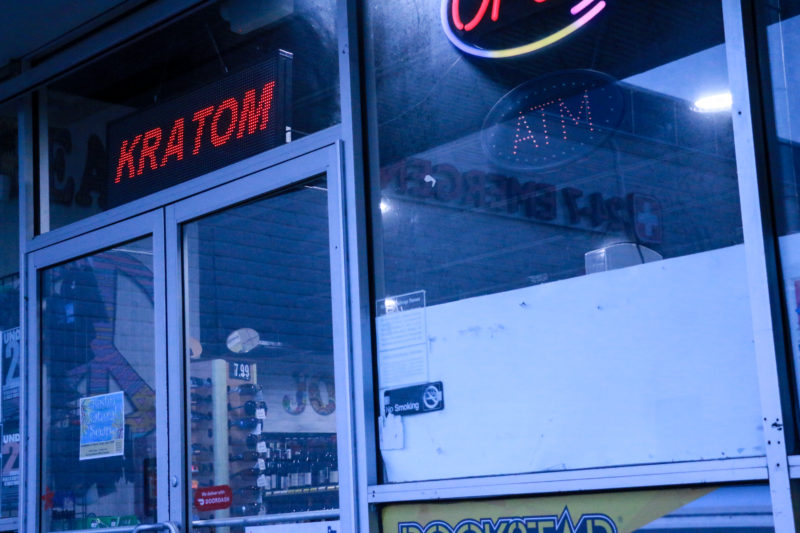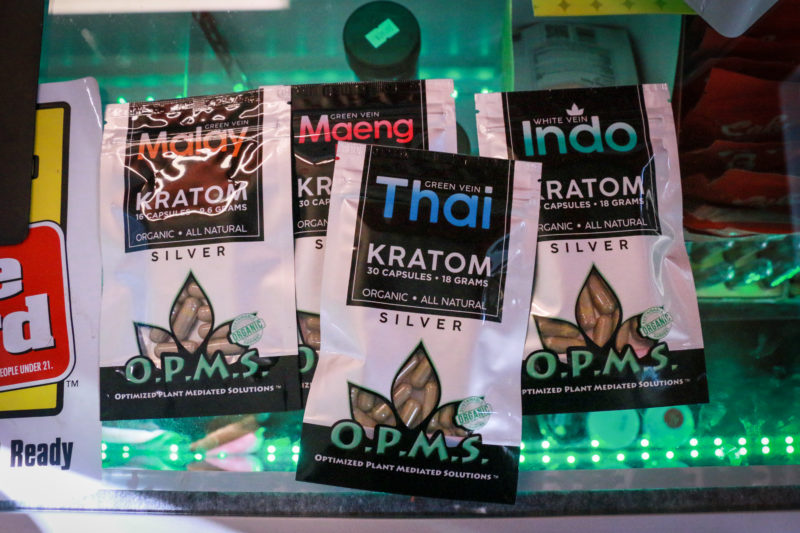‘It’s a Free for All’: Kratom Is Legal in Texas But Should it Be?
By Samuel Stark
Reporting Texas

A sign advertises kratom in a convenience store window in the Riverside neighborhood of Austin. Samuel Stark/Reporting Texas
Madison Farrell says her own experience with substance dependency inspired her to work in recovery. Clean for four years, the 30-year-old Farrell works as an admissions specialist at Infinite Recovery in Austin, where she is seeing more people dealing with addiction to a little-known drug that remains legal in Texas and 44 other states.
It is called kratom. Supporters tout it as a safer alternative to opiates such as heroin and fentanyl, but medical professionals in Texas describe kratom as being addictive and dangerous and call for it to be categorized as a scheduled substance. Under the Controlled Substance Act, the Drug Enforcement Administration classifies drugs into categories, or schedules, based on perceived danger for abuse.
Farrell has personal experience with the drug: Her ex-boyfriend was addicted to kratom and hid the addiction from her while they dated, she said.
“Finally, two and a half years into our dating, he disclosed to me that he had been taking (kratom) since he first got sober.” Farrell said. “What started as, ‘Ah I’ll just take this for a couple of days.’ turned into a dependence that lasted years,” she added.
Eventually Farrell’s ex-boyfriend was able to stop using kratom, she added.
“He said the withdrawal from the kratom was worse than when he was taking opiates,” Farrell said. “We ended up not making it through that as a couple.”
Kratom is a tropical evergreen tree native to Southeast Asia. Its leaves contain compounds that can produce an opioid-like high if enough is consumed, usually in capsule or powder form. The kratom industry in the U.S. is unregulated, and in Texas, if you’re over the age of 18, the substance is easily accessible online or in smoke shops.
“The problem is … kratom is totally unregulated,” Dr. Sidarth Wakhlu, a professor and clinician who studies and treats substance abuse disorders at the University of Texas Southwestern, told Reporting Texas. “It’s a free for all.”

A selection of kratom products sit on the shelves of Suru CBD & Smoke Shop on East Sixth Street in Austin. Optimized Plant Mediated Solutions, or OPMS, the manufacturer of the products shown, claims to be the “industry-leading supplier of Kratom extract for more than 5 years,” according to their website. Samuel Stark/Reporting Texas
Kratom was first documented in medical literature in the early 1900s. In Southeast Asia, it is used to stave off lethargy and pain, as a deworming agent and to curb heroin addiction. Southeast Asia, often referred to as “The Golden Triangle,” is known for producing heroin.
“We have not seen much in terms of major (kratom) addiction in that part of the world,” Wakhlu said.
That is not the case in Texas, where kratom addiction cases have been rising for a decade. “They’re seeing fewer addictions to kratom in Southeast Asia because the natural kratom that people are using over there is much weaker in effect than the stuff that is currently legal on Texas shelves,” Wakhlu said.
Because there is no regulation, kratom manufacturers are adding more of the chemical in kratom that acts on the opioid centers in the brain, Wakhlu said.
“And when people stop using it, they go into a withdrawal comparable to the one someone would go through with heroin or oxycodone,” Wakhlu said.
Withdrawal symptoms from kratom include muscle cramps, insomnia, diarrhea, increased sweating and chills.
“I wish It would be gone completely,” Farrell said. “I hate what it’s done to our recovery community.
“(Kratom) is not as bad as the epidemic (the U.S.) is facing with fentanyl and heroin,” Farrell said, but it’s still extremely dangerous. For some people, kratom is a gateway drug to heroin usage, she said. Others might stop using heroin and start using kratom “only to get addicted to (kratom),” she added.

Madison Farrell, 30, an admissions specialist at Infinite Recovery in Austin, hopes to begin a nursing program at Aspen University next year. She has been in recovery herself for over four years. Samuel Stark/Reporting Texas
From January to October 2021, the Texas Poison Control Center received 81 calls related to kratom overdoses, said Dr. Shawn Varney, medical director of the South Texas Poison Center. “Cases that are recorded are clearly only a portion of all the cases out there. … How many people are not voluntarily calling when they have problems? We don’t know.”
Of the 81 overdose cases, no one died, but 11 people required significant medical intervention, Varney said. One patient’s heart stopped, and he required CPR to be resuscitated.
“To have your heart stop, and it being attributed to kratom, well, that’s significant,” Varney said. “Just because this isn’t one of those, quote unquote, dangerous opioids, it doesn’t mean it’s without error or potential for harm.
“You have no idea what impurities, contaminants, what else it is tainted with. You may think you’re buying pure kratom, and it may be mixed with other agents. There is no quality control,” Varney said.
Supporters of kratom say it should remain legal and tout it as an effective painkiller that can soothe difficult symptoms from opioid withdrawal.
The largest pro-kratom advocacy group in the U.S. is the American Kratom Association, which claims that millions of Americans use kratom for “health and wellness.” The group’s position is that everyone should have access to kratom but that it should be regulated. The association has accused the Food and Drug Administration of waging a kratom “disinformation campaign.”
The FDA website warns consumers not to use kratom. “(The) FDA is concerned that kratom, which affects the same opioid brain receptors as morphine, appears to have properties that expose users to the risks of addiction, abuse and dependence,” the website states.
The World Health Organization’s Committee on Drug Dependence heard arguments in support of kratom in October and is expected to issue a report on the drug in 2022.
Kratom first appeared in the U.S. around 2007, Wakhlu said. “People were touting it for pain, energy, depression and (eventually) people started getting concerned about it in the literature,” Wakhlu said.
In 2016, the DEA tried to classify kratom as a Schedule 1 drug. “Oh my god, there was an outcry. The DEA got letters from senators, congressmen and the DEA backed off,” Wakhlu said.
So far, five states — Alabama, Arkansas, Indiana, Wisconsin and Vermont — have banned kratom.
Since kratom’s emergence in the U.S., nickel and lead have been found in kratom products, Wakhlu said. “In 2018 there was an outbreak of salmonella from people who were consuming kratom products.”
“I think this needs to be scheduled as Schedule I. There are no ands ifs or buts about it,” Wakhlu said.